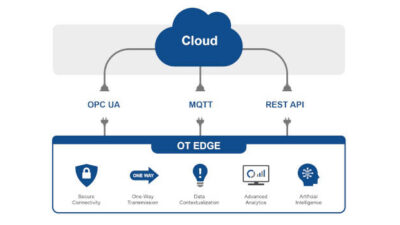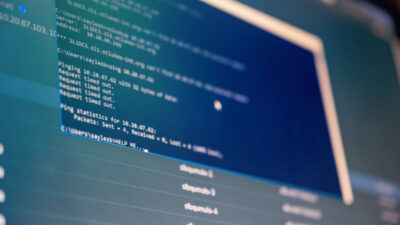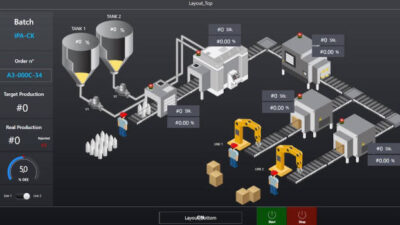Will that personal computer (PC) on your desk be controlling the next machine installed in your factory? Some say, "Yes, the PLC is dead as a control platform." To others, the PLC is not dead, it is morphing.At times this discussion sounds like a religious debate. But users need not be locked into an either/or decision about the future control platform for their factories.
KEY WORDS
Machine control
Programmable logic controllers (PLCs)
Industrial computers
Software for control
Microsoft Windows
Sidebars: Control checklist Varieties of Controllers
Will that personal computer (PC) on your desk be controlling the next machine installed in your factory? Some say, “Yes, the PLC is dead as a control platform.” To others, the PLC is not dead, it is morphing.
At times this discussion sounds like a religious debate. But users need not be locked into an either/or decision about the future control platform for their factories. PCs are gaining application experience while the PLC platform is in a period of change (see the May 1998 issue of Control Engineering , “PLCs Adapt, but Will They Withstand the Assault of PCs?”) sometimes even placing a PC in the rack.
The differences are not only hardware. Many advantages of PCs lie in the programming tools and methods they use. Most PLCs use a form of relay ladder logic (RLL). Originally used because of its similarity with relay diagrams familiar to engineers and technicians, RLL has evolved from simple contact and coil logic to handling math and communications.
PCs running on standard operating systems like Microsoft Windows NT enable programmers to use tools such as function block or flow chart programming. These are graphical in nature and designed for better math and communications, as well as improved diagnostics and analysis. (Look for a discussion of programming tools in the December 1998 CE .)
Increased options for control
PC-based control is commonly known as “open” control, which means that much of the hardware used is derived from commercially available components. Future additions to the system need not be purchased from the same vendor. If another vendor has a product that fits the task to be done, that product can be integrated into the system saving time and money.
Willingness of engineers to pursue open control has allowed many new companies to enter the control market. The number of companies cited in this article demonstrates this explosion. This has resulted in a barrage of new and innovative control solutions. Market leaders have felt this pressure and are responding to the challenge.
Bill Thompson, an analyst with Automation Research Corp. (ARC, Dedham, Mass.) who covers machine control, says, “While the use of personal computers in the plant is not a new concept, acceptance of PCs for direct control in discrete and continuous applications is rapidly gaining momentum.”
“The value of automation is shifting toward software content. The cost of software has surpassed the value of hardware,” Mr. Thompson adds. “Preservation of this investment is essential in the minimization of total cost of ownership. Industry is moving toward software applications that are platform independent further shifting value to the application software.”
He continues, “As migration from proprietary platforms to PCs continues, implementation of control solutions in PC software or dedicated Microsoft Windows CE-based hardware will dominate the plant floor. Even in time-critical motion control applications the PC has proven to be viable platform.”
Alliances provide solutions
Intellution (Norwood, Mass.), a subsidiary of Emerson Electric, is known for its HMI (human-machine interface) and supervisory control and data acquisition (SCADA) software, FIX Dynamics. Paradym-31 machine control software has been integrated into the FIX package of software components. Paradym-31 uses the familiar interface of Windows NT but has a real-time, deterministic core. It features IEC 61131-3 standard programming languages along with built-in simulation.
For customers who desire a complete solution from a single source, a partnership has been formed by Intellution, Octagon Systems (Westminster, Colo.), and Opto 22 (Temecula, Calif.). Octagon Systems provides the hardware platform for Paradym-31. The input/output devices are Snap I/O from Opto 22. These devices are high-density I/O modules with an available control module capable of running lower level control such as PID loops without loading the main controller.
Opto 22 also has a PC-based automation solution—OptoControl. This package uses flow-chart programming. Flow-charts are not recognized by IEC 61131-3, but proponents point to its ease of use and inherent ability to provide for diagnostic information. Vice president Bob Sheffres notes, “Customers want more intelligent I/O, easily integrated with software that takes advantage of that intelligence delivered over a standard network. That network is Ethernet.” Opto 22’s solution includes flow-chart control logic communicating over Ethernet to Snap I/O.
Steeplechase Software (Ann Arbor, Mich.) is a long-time proponent of flow-chart programming. One major benefit of this programming method is easily integrated diagnostic logic.
Long known for operator interface products, Cutler-Hammer/Eaton (Westerville, O.) has committed to PC-based control. Business development manager Ted Schneider sees the market moving this direction. The iPC line of industrial computers includes a full-size box with Intel Pentium II processor and a micro-iPC with an 8.4-in. touchscreen monitor that fits in a 9.25- × 6.5-in. cutout. NetSolver control software is a flow-chart control package that features a Windows-Explorer-type interface. Cutler-Hammer has partnered with Steeplechase on some projects including the one at Chrysler.
ASAP (Chagrin Falls, O.) has taken partnership to another level. The developer and marketer of the ASIC line of software control products has merged with Xycom Inc. (Saline, Mich.), a manufacturer of PC industrial workstations. While each will sell its individual products, a combination of products provide a complete control solution. ASIC-300 is a scalable control package that will run under Windows NT, Windows CE, or any real time operating system for embedded applications. Vice president Paul Hamilton sees the best feature of software control as the ability to easily integrate different functions, such as logic and motion control, into one box.
Industrial bus computers
VMIC (Huntsville, Ala.) has moved beyond its beginnings as a supplier of VMEbus computer systems. Hardware solutions now also include compactPCI and PCI. I/O Works is VMIC’s control software. Programming languages include RLL and function block with the other IEC 1131-3 languages in development. I/O Works runs under Windows NT, CE, or VenturCom’s (Cambridge, Mass.) real time extension for NT—RTX. It supports OPC (OLE for Process Control), and ODBC (Open Data Base Consortium) connectivity for data handling and ActiveX controls. I/O Works also supports parallel processing.
Wonderware’s (Irvine, Calif.) InControl is a Windows NT-based runtime and IEC 61131-3 graphical development environment. It interfaces to a wide variety of open and legacy I/O systems, has ActiveX extensibility, and integrates with Wonderware FactorySuite. InControl is used in complex control applications combining its discrete and process control capabilities with user specific ActiveX interfaces to vision and motion systems, providing hybridized control.
John Bergsten, software vice president at Total Control Products (Melrose Park, Ill.) cites reasons to choose PC control. “Its ability to easily integrate with third-party applications—such as Manufacturing Resource Planning (MRP), Enterprise Resource Planning (ERP), and production scheduling systems—is one reason. As manufacturers look at the factory in broader terms, linking production processes becomes critical to competitiveness. The ability to make on-line changes to applications or to design, develop, install and start up new or retrofitted production lines is critical. Open environments that accommodate easy integration into other plant systems reduce the time and cost of changing to meet new demands.”
The demand for integration has led the development of object-oriented software technology such as Total Control’s FrameworX. FrameworX allows PC control, HMI, and system management software to operate in a single, Windows-based workspace.
PLCs in software
A new entry in the soft control market is computer workstation and HMI vendor CTC Parker (Milford, O.). According to Mike Smith, division marketing manager, CTC is adding a DOS-based real time operating system control program to its suite of software products. Code named “Miami,” this program will look like PLC programming in the five IEC 61131-3 languages. As a real-time system, a hard disk is not required for operation removing a potential source of failure. The Interact HMI software can copy from the same tag database eliminating the need to type all tags a second time. Packaged in a small unit, “Miami” is priced competitively with small PLCs.
A company using the cross-platform power of Java is SoftPLC (Humble, Tex.). The instruction set, files, and addressing are almost like an Allen-Bradley PLC-5. The latest version is an embedded Java virtual machine that does not require a keyboard or disk to operate. The IT department can read production data using a web browser over TCP/IP networking. The SoftPLC can write to databases such as Oracle on Unix since Java is platform independent. It can send e-mail messages to personnel alerting them about potential problems, downtime, etc. HMIs are easily constructed using standard web browsers.
PEP Modular Computers’ (Kaufbeuren, Germany) product manager Klaus Martin says, “The customer benefits from these new systems by a shorter time-to-market. Further advantages are off-the-shelf software and the abundance of third-party hardware.”
He forecasts, “There will be increased investment in distributed systems connected via fieldbus or Ethernet depending upon the requirements of the system. Whereas open fieldbus technology is well-known in Europe, the opening of DeviceNet in the United States gives vendors access to a larger base. Opening of DeviceNet will also have an effect in Europe.”
A supplier of PLCs and PCs in CompactPCI and VMEbus forms, PEP supports several operating systems including Windows NT, Sun Solaris, Linux, and QNX. Programming is IEC 61131-3 compliant.
National Instruments (Austin, Tex.) is a well-known supplier of data acquisition components and SCADA software. Bridgeview, Labview, and Lookout products also are increasingly used for control of industrial processes. Motion control and vision systems have been integrated into the software. Look for this company to expand the PC-based control scene. Director of industrial automation marketing Mike Santori advises, “The benefits of PC control lie in integrated functions, sometimes lower cost, analysis, connectivity, development tools, and data handling.”
Empires strike back
There are a lot of new players to pick from in industrial control thanks to the explosion of software-based open systems. Does this mean that PLC vendors are waving a white flag of surrender? Hardly.
PLC Direct (Cumming, Ga.) introduced the WinPLC which integrates the power and well-known interface of Windows on a PC platform with the convenience and small footprint of PLC I/O modules. WinPLC has a Windows CE operating system. This is a condensed OS, which does not require a hard disk to operate or load, is coupled with Think & Do control software. The Think & Do package is a flow chart programming tool which has the capability to integrate control, motion, HMI, and PID.
Jeff Meyers, system components marketing manager for Omron Electronics (Schaumburg, Ill.), reports, “Many users have implemented a mix of PC and PLC-based solutions. For standalone machine control, PLC solutions are generally more cost-effective and easier to implement. However, as end-users increasingly seek to network their machines together, PC technology is becoming more widespread.”
Omron’s just introduced Sysmac Board PLC combines the capabilities of a PLC with a DeviceNet scanner board. This single-slot ISA board operates independently of the host computer, but can exchange data with the PC via C programming language functions provided in the board’s library.
Create better systems
“With an increase in choices, control systems now require more thorough planning than ever,” states Vince Tullo, vice president of PLC business at GE Fanuc Automation (Charlottesville, Va.). “This freedom of choice may complicate the design process, but it allows engineers to create better systems—if they take advantage of proven methods for selecting a strategy.”
GE Fanuc’s new VersaMax PLC and I/O system offers a controller plus an I/O platform designed for integration into PC-based systems. In addition, the latest release of PC Control, an IEC 61131-3 compliant programming and control package, enables the programmer to write functions or function blocks in “C” so integrators can provide value-added features specific to their industry or product.
Kevin Heisey, SoftLogix application engineer at Rockwell Automation/Allen-Bradley (Mayfield Heights, O.) suggests looking at PC-based control when “you need to combine HMI with the control engine or need higher-speed graphics. Consider SoftLogix when a PLC runs out of memory or when databases have to be outside the PLC.”
A Rockwell Automation/Texas Instruments Materials and Controls Group (Attleboro, Mass.) project to build a pressure switch assembly and test machine used SoftLogix PC-based control. The system improved information flow enabling plant personnel to view and compare a machine’s efficiency. Since SoftLogix looks and programs like a PLC5, Texas Instruments was able to reuse existing technology knowledge. The recommendation: do not dismiss PC-based control and do not “throw away” PLC-based control. Each is a viable choice.
Monty Fox, senior product marketing engineer at Mitsubishi Electric Automation (Vernon Hills, Ill.) says that the real strategy for PC-based control is to make the PC as robust as the PLC. To do this, Mitsubishi uses the Intime (formerly iRMX) real-time kernel under Windows NT in the MC2 (Melsoft Computer Control) package. One of the major benefits of flow-chart control on a PC is diagnostic capability. With MC2’s Diagnostic Wizard, a programmer fills in a few key fault-routine fields and the software automatically generates a flowchart program. This can be a big time-saver when writing fault routines.
Information devices
“PLCs are taking on a new role as information devices,” says Eric Marks, strategic marketing manager for Schneider Automation (North Andover, Mass).
“We have PLCs with an embedded http server or Cycle Software LiveData Server. TCP/IP networking over Ethernet makes what used to be a proprietary device capable of sending e-mails, publishing web content over an industrial intranet, and triggering relational database transactions using open technology from the IT world.”
Siemens Energy & Automation (Alpharetta, Ga.) has forged into PC-based control with WinAC. This package—consisting of an ISA-slot board with software—looks like a Simatic S7 to the programmer and integrates with HMI software. A Windows NT-based program, WinAC uses the Windows tools OPC, ActiveX, and Visual Basic. WinAC is part of Siemens’ Totally Integrated Automation (TIA) solution. TIA incorporates uniform data management, communication, configuration, and programming into one system.
The choice is yours
Just like the principles of free-market economics taught in your Economics 101 class, this competition is making everyone think of better ways to solve your control problems.
Now, you have to decide how to assemble that new control system. Will you be using PCs in the near future? Will your future factory mix control platforms?
Control checklist
Checking these questions will help your automation supplier(s) provide appropriate solutions.
Does your control requirement have:
Small amount of discrete I/O points?
Large amount of I/O points in a rather contained area?
High speed, deterministic control requirement?
Need to eliminate or reduce size of control enclosures?
Handling large amounts of data?
Connectivity to plant information technology system?
Large amounts of graphical data to display?
Need for central control of I/O devices distributed over a large area?
Varieties of Controllers
Micro PLC —For isolated control of small amounts of I/O points or distributed control.
Programmable Logic Controller (PLC) —For control of machines or processes in a traditional manner; often a modular architecture with the controller occupying a slot in a rack with Input/Output and communication modules.
Personal Computer (PC) —Variations of the familiar desktop PC for control of a machine or process often when integrated HMI (Human-Machine Interface) is required or large amounts of data are handled. Other factors include easier networking and use of Microsoft Windows NT operating system with commonly known application software.
Single board PC —PC control in an “industrial” form factor, available in VME, STD32, ISA, PCI, Compact PCI, and even PLC form factors, also usually with Windows NT operating system.
Embedded control —computer board with Windows CE or Java embedded in firmware. Does not require disk drive to load or operate system. Can be in the form of a single-board PC or PLC controller. With Windows CE, software is still in the Windows “environment.” With Java it is easy to adapt information to the World Wide Web format.
Software —Often known as soft logic or soft control, the control logic that runs on PC-based systems. Usually written to run on Windows NT or CE, but there are some Java-based programs.
IEC 61131-3 — A European-based standard for programming languages, provides for uniform approaches to functions. It recognizes five standard “languages:” ladder logic, sequential function chart, function block, structured text, and instruction list. Look for a discussion of programming tools in the December 1998 CE.



